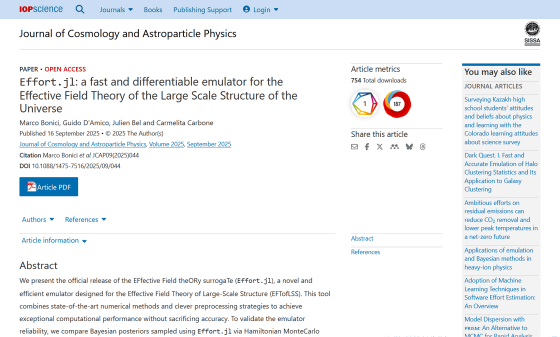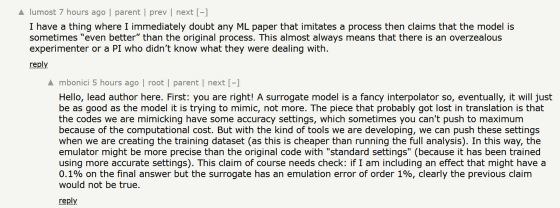A powerful emulator 'Effort.jl' that can run space simulations that once required a supercomputer on a laptop

Astronomers have long relied on supercomputers with their enormous computing power to simulate the vast structures of the universe, but a new emulation tool called Effort.jl claims to be able to mimic the behavior of complex cosmological models and produce supercomputer-equivalent results in just a few minutes on a standard laptop.
Effort.jl: a fast and differentiable emulator for the Effective Field Theory of the Large Scale Structure of the Universe - IOPscience

GitHub - CosmologicalEmulators/Effort.jl: Repository containing the EFfective Field theORy surrogaTe
https://github.com/CosmologicalEmulators/Effort.jl
Cosmic simulations that once needed supercomputers now run on a laptop | ScienceDaily
https://www.sciencedaily.com/releases/2025/09/250918225001.htm
To understand the vast universe, astronomers combine the laws of physics with data from astronomical observational instruments to build theoretical models, such as the 'effective field theory of large-scale structure (EFTofLSS),' which is a framework for understanding large-scale structure like the universe. These theoretical models provide a statistical description of the structure of the universe based on observational data, allowing us to estimate key parameters.
However, running a model like EFTofLSS requires a significant amount of time and computational resources, and with the exponential growth in available astronomical datasets due to advances in space observation equipment in recent years, a lightweight method for analysis without sacrificing accuracy is needed.
Emulators, which mimic the response of theoretical models and operate much faster, are gaining attention. Emulators can be a shortcut to outputting data-based analysis results, but because they are not the same as the underlying model, there is a risk of losing accuracy.
Now, an international research team including the Italian National Institute for Astrophysics (INAF) , the University of Parma , and the University of Waterloo has released a new emulator, 'Effort.jl,' designed for EFTofLSS.
In their tests, the researchers found that Effort.jl could be run in minutes on a standard laptop rather than a supercomputer, and achieved essentially the same accuracy as its predecessor, EFTofLSS, and in some cases even reproduced finer details than the original model.

Theoretical models provide statistical explanations of the structures that give rise to the collected data, but with the exponential growth in the amount of data available today, implementing them would be extremely time-consuming and costly. Emulators use neural networks to learn the output for each input parameter, allowing them to handle never-before-seen parameter combinations.
'That's why we're turning to emulators, which can significantly reduce the time and resources required,' said Marco Bonnici of the University of Waterloo, lead author of the paper.
It's important to note that the emulator doesn't understand the physics itself, but rather how a theoretical model responds to inputs. Effort.jl further shortens the training phase by incorporating knowledge into the algorithm about how predictions change when parameters are changed.
Effort.jl has also become a hot topic on the social news site Hacker News, with one user commenting, 'I'm immediately skeptical of machine learning papers that mimic a specific process and then claim that the resulting model is 'even better' than the original process.' Bonnici responded, 'First of all, you're right! The surrogate model is a sophisticated interpolator, so ultimately it can only achieve accuracy comparable to the model it's imitating.' He went on to explain that if the precision settings in the code being imitated are limited due to computational cost, then using a cheaper emulator to increase the precision settings can potentially produce higher accuracy than the original model with standard settings.
